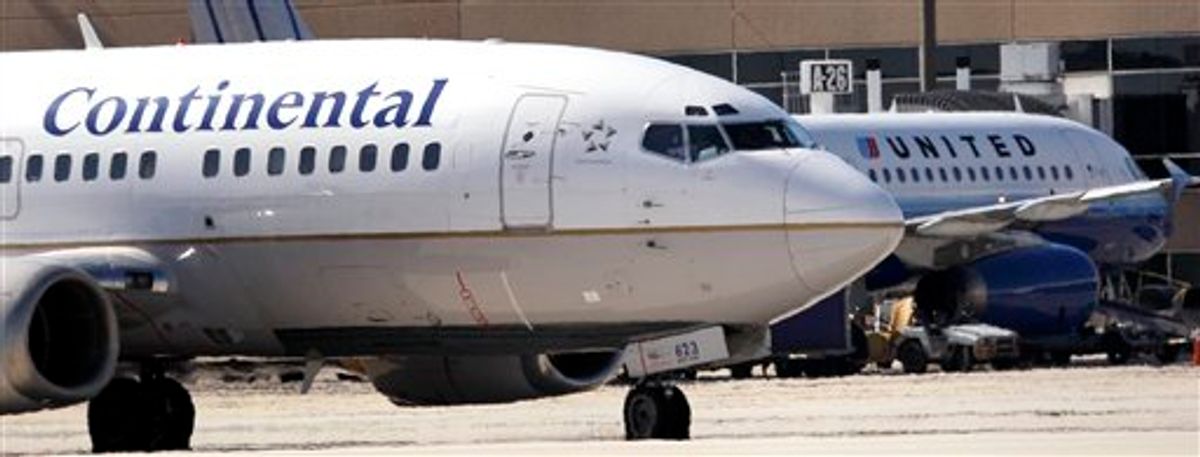The big, if entirely expected story is Monday's announced merger between United Airlines and Continental Airlines.
At the moment, United is the world's third-biggest carrier, transporting 63 million passengers annually and logging 17.7 billion revenue passenger kilometers. Continental ranks fifth, with 49 million customers and 13.3 billion RPKs. Stick them together and you've got the largest airline on the planet, operating 750 aircraft -- including an immense fleet of long-haul widebodies -- to 59 countries. The new combo leapfrogs ahead of Delta, which took world's biggest mantle after its merger with Northwest earlier this year.
Strategically, the combined carrier makes sense much the way Delta-Northwest made sense. Delta covered much of Europe, reaching into India and the Persian Gulf, plus multiple destinations in Africa. Northwest had been flying across the Pacific for 50 years, serving more than a dozen Asian cities, including coveted routes into China. Together, they're big everywhere. United-Continental takes advantage of Continental's heavy East Coast presence (Newark hub), and its considerable transatlantic and Latin American networks. United contributes its West Coast presence and Pacific network, including its hub at Tokyo-Narita.
So this is the latest chapter in the industry consolidation people have been talking about ever since the airline apocalypse that followed Sept. 11. Northwest-Delta, US Airways-America West, United-Continental. Are yet more mergers on tap? Possibly.
This is worrying to some consumers. Doesn't industry consolidation mean higher fares? The answer is maybe, to some degree, in certain markets. But on the whole, no, and there will still be plenty of competition out there, both domestically and internationally. And on the upside, consolidation means more rationalized scheduling practices and less congestion. Honestly, passengers have less to be concerned about than the employees of these airlines. Mergers often result in fleet trimming, which in turn brings redundancies and layoffs.
In any case, nothing about the United-Continental deal is a done deal. Airline mergers are notoriously knotty, and things could grow contentious as the paperwork wends its way through the approval process. Nothing will be official until the Department of Justice, Department of Transportation and the unions all sign off. How long that might take is anybody's guess, but you can anticipate a year or so before airplanes are repainted.
And that brings us to the fun part.
The combined airline will carry the United name, which has slightly more global recognition (and fewer syllables) than Continental, but will wear the Continental livery. I'm not sure this works, branding-wise.
In my mind, United just ain't United without the iconic, four-petaled U on the tail. Meanwhile, the flanks of Continental's planes are an attractive, two-tone white/gray with a slender gold stripe, but the logo -- a sectioned globe in relief against a navy background -- looks like a PowerPoint presentation. It would be handsome if it weren't so immaculately inoffensive. This was a good opportunity to rejigger the whole design. Instead, slapping the United name onto the side makes for one oddball hybrid.
And as for the name, I'm disappointed they didn't go for my own suggestion: Continented.
There's a fine line, sometimes, between a merger and an outright takeover. Here are some of history's most notable airline combos:
United / Continental (pending)
Delta / Northwest
Air France / KLM *
America West / US Airways
American / TWA
Air Canada / Canadian Airlines
Air France / UTA
Northwest / Republic
Delta / Western
Continental / Frontier
Continental / PeopleExpress
Pan Am / National Airlines
* AF and KLM are legally merged, yet continue to have separate operational structures and employee groups. Married, living apart, you could say.
- - - - - - - - - - - -
Do you have questions for Salon's aviation expert? Contact Patrick Smith through his Web site and look for answers in a future column.

Shares